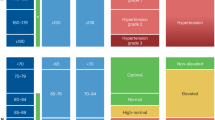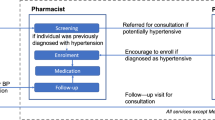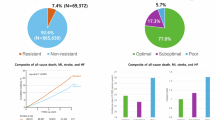Abstract
Measures of adherence to hypertension guidelines have historically been based on prescription data or physician survey data regarding treatment practices. These methods have limitations that decrease their accuracy. As part of a randomized controlled study testing the effects of pharmacist/physician collaboration on adherence to hypertension guidelines, the investigators and an expert panel developed a JNC 7 measurement tool. The final guideline adherence measurement tool includes 22 explicit criteria in four domains of care. An exploratory factor analysis, conducted to assess the structure of the tool, suggests three underlying treatment dimensions in hypertension care. The adherence measurement tool will allow researchers to link specific elements of care to improved blood pressure control. In addition, use of the tool will provide clinicians with a taxonomy for evaluating practice and describing the effect of improved patient care on patient outcomes.
This is a preview of subscription content, access via your institution
Access options
Subscribe to this journal
Receive 12 digital issues and online access to articles
$119.00 per year
only $9.92 per issue
Buy this article
- Purchase on SpringerLink
- Instant access to full article PDF
Prices may be subject to local taxes which are calculated during checkout

Similar content being viewed by others
References
Ashton CM, Kuykendall DH, Johnson ML, Wun CC, Wray NP, Carr MJ et al. A method of developing and weighting explicit process of care criteria for quality assessment. Med Care 1994; 32 (8): 755–770.
Brook RH, McGlynn EA, Cleary PD . Quality of health care. Part 2: measuring quality of care. N Engl J Med 1996; 335 (13): 966–970.
Lohr KN, Donaldson MS, Harris-Wehling J . Medicare: a strategy for quality assurance, V: quality of care in a changing health care environment. QRB Qual Rev Bull 1992; 18 (4): 120–126.
Becher EC, Chassin MR . Improving the quality of health care: who will lead? Health Affair (Millwood) 2001; 20 (5): 164–179.
Milchak JL, Carter BL, James PA, Ardery G . Measuring adherence to practice guidelines for the management of hypertension: an evaluation of the literature. Hypertension 2004; 44 (5): 602–608.
Nelson CR, Knapp DA . Trends in antihypertensive drug therapy of ambulatory patients by US office-based physicians. Hypertension 2000; 36 (4): 600–603.
Siegel D, Lopez J . Trends in antihypertensive drug use in the United States: do the JNC V recommendations affect prescribing? Fifth Joint National Commission on the Detection, Evaluation, and Treatment of High Blood Pressure. JAMA 1997; 278 (21): 1745–1748.
Clause SL, Hamilton RA . Medicaid prescriber compliance with Joint National Committee VI Hypertension Treatment Guidelines. Ann Pharmacother 2002; 36 (10): 1505–1511.
Carter BL, Malone DC, Ellis SL, Dombrowski RC . Antihypertensive drug utilization in hypertensive veterans with complex medication profiles. J Clin Hypertens 2000; 2 (3): 172–180.
Monane M, Glynn RJ, Gurwitz JH, Bohn RL, Levin R, Avorn J . Trends in medication choices for hypertension in the elderly. The decline of the thiazides. Hypertension 1995; 25 (5): 1045–1051.
Asch SM, Kerr EA, Lapuerta P, Law A, McGlynn EA . A new approach for measuring quality of care for women with hypertension. Arch Intern Med 2001; 161 (10): 1329–1335.
Cuspidi C, Michev I, Lonati L, Vaccarella A, Cristofari M, Garavelli G et al. Compliance to hypertension guidelines in clinical practice: a multicentre pilot study in Italy. J Hum Hypertens 2002; 16 (10): 699–703.
McAlister FA, Teo KK, Lewanczuk RZ, Wells G, Montague TJ . Contemporary practice patterns in the management of newly diagnosed hypertension. CMAJ 1997; 157 (1): 23–30.
Mehta SS, Wilcox CS, Schulman KA . Treatment of hypertension in patients with comorbidities: results from the study of hypertensive prescribing practices (SHyPP). Am J Hypertens 1999; 12 (4 Part 1): 333–340.
Chobanian AV, Bakris GL, Black HR, Cushman WC, Green LA, Izzo Jr JL et al. Seventh report of the Joint National Committee on Prevention, Detection, Evaluation, and Treatment of High Blood Pressure. Hypertension 2003; 42 (6): 1206–1252.
Lohr KN . Medicare: A Strategy for Quality Assurance. National Academy Press: Washington, DC, 1990.
Fink A, Kosecoff J, Chassin M, Brook RH . Consensus methods: characteristics and guidelines for use. Am J Public Health 1984; 74 (9): 979–983.
Mates S, Sidel VW . Quality assessment by process and outcome methods: evaluation of emergency room care of asthmatic adults. Am J Public Health 1981; 71 (7): 687–693.
Advani A, Goldstein M, Musen MA . A framework for evidence-adaptive quality assessment that unifies guideline-based and performance-indicator approaches. Proc AMIA Symp 2002, 2–6.
Rubenstein L, Mates S, Sidel VW . Quality-of-care assessment by process and outcome scoring. Use of weighted algorithmic assessment criteria for evaluation of emergency room care of women with symptoms of urinary tract infection. Ann Intern Med 1977; 86 (5): 617–625.
Advani A, Shahar Y, Musen MA . Medical quality assessment by scoring adherence to guideline intentions. Proc AMIA Symp 2001, 2–6.
Kim J, Mueller CW . Introduction to Factor Analysis: What It is and How to Do It. Sage Publications: Beverly Hills and London, 1976.
Nunnally JC . Psychometric Theory, 2nd edn. McGraw-Hill: New York, 1978.
Cattell RB . The scree test for the number of factors. Multivar Behav Res 1966; 1: 245–276.
Tufo HM, Speidel JJ . Problems with medical records. Med Care 1971; 9 (6): 509–517.
Romm FJ, Putnam SM . The validity of the medical record. Med Care 1981; 19 (3): 310–315.
Bentsen BG . The accuracy of recording patient problems in family practice. J Med Educ 1976; 51 (4): 311–316.
Lyons TF, Payne BC . The relationship of physicians' medical recording performance to their medical care performance. Med Care 1974; 12 (8): 714–720.
Zuckerman ZE, Starfield B, Hochreiter C, Kovasznay B . Validating the content of pediatric outpatient medical records by means of tape-recording doctor–patient encounters. Pediatrics 1975; 56 (3): 407–411.
Acknowledgements
This manuscript is supported in part by a grant from the National Institutes of Health R01 HL070740. We thank Carrie Franciscus for her skilled programming efforts.
Author information
Authors and Affiliations
Corresponding author
Rights and permissions
About this article
Cite this article
Milchak, J., Carter, B., Ardery, G. et al. Development of explicit criteria to measure adherence to hypertension guidelines. J Hum Hypertens 20, 426–433 (2006). https://doi.org/10.1038/sj.jhh.1002005
Received:
Revised:
Accepted:
Published:
Issue date:
DOI: https://doi.org/10.1038/sj.jhh.1002005
Keywords
This article is cited by
-
Adherence of doctors to hypertension clinical guidelines in academy charity teaching hospital, Khartoum, Sudan
BMC Health Services Research (2019)
-
Online Treatment Compliance Checking for Clinical Pathways
Journal of Medical Systems (2014)
-
Hypertension Guideline Adherence Among Nursing Home Patients
Journal of General Internal Medicine (2009)
-
Accumulation of 30 min of moderately intense physical activity is a clinically meaningful treatment to reduce systolic blood pressure in prehypertension
Journal of Human Hypertension (2008)
-
Managing cardiovascular risk: the need for change
Journal of Human Hypertension (2008)



